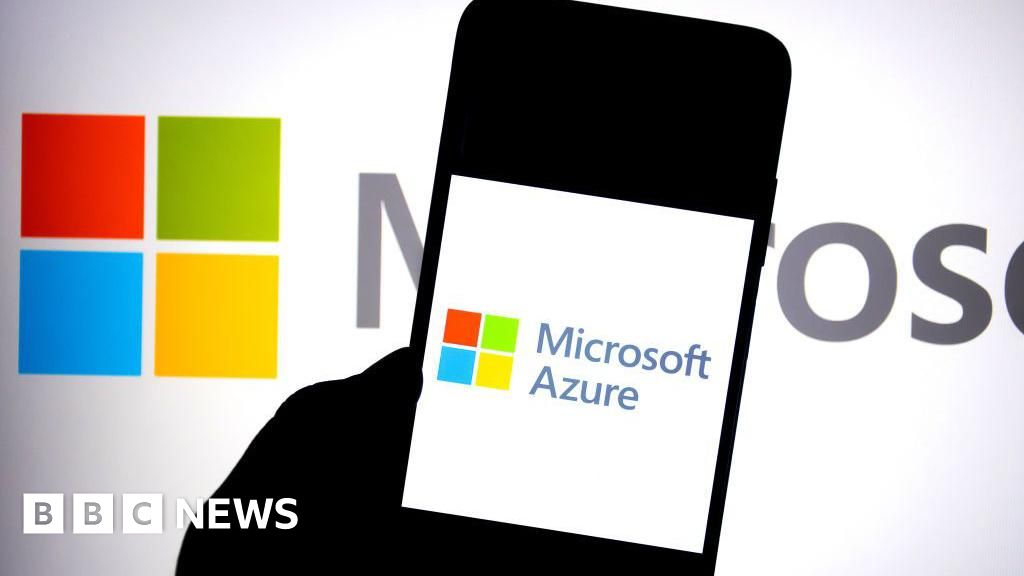Business
Microsoft Azure outage: Websites come back online

Imran Rahman-Jones,Technology reporter and
Lily Jamali,North America Technology correspondent
 Getty Images
Getty ImagesWebsites for Heathrow, NatWest and Minecraft returned to service late on Wednesday after experiencing problems amid a global Microsoft outage.
Outage tracker Downdetector showed thousands of reports of issues with a number of websites around the world over several hours.
Microsoft said some users of Microsoft 365 saw delays with Outlook among other services, but by 21:00GMT, many websites that went down were once again accessible after the company restored a prior update.
The company’s Azure cloud computing platform, which underpins large parts of the internet, had reported a “degradation of some services” at 16:00 GMT.
It said this was due to “DNS issues” – the same root cause of the huge Amazon Web Services (AWS) outage last week.
Amazon said AWS was operating normally.
Other sites that were impacted in the UK include supermarket Asda and mobile phone operator O2 – while in the US, people reported issues accessing the websites of coffee chain Starbucks and retailer Kroger.
The M&S website remained unavailable late on Wednesday even after many others returned online.
Microsoft said business Microsoft 365 customers experienced problems.
Some web pages on Microsoft also directed users to an error notifications that read “Uh oh! Something went wrong with the previous request.”
The tech giant resorted to posting updates to a thread on X after some users reported they could not access the service status page.
While NatWest’s website was temporarily impacted, the bank’s mobile banking, web chat, and telephone customer services remained available during the outage.
Meanwhile, business at the Scottish Parliament was suspended because of technical issues with the parliament’s online voting system.
The outage prompted a postponement of debate over land reform legislation that could allow Scotland to intervene in private sales and require large estates to be broken up.
A senior Scottish Parliament source told BBC News they believed the problems were related to the Microsoft outage.
Azure’s crucial role online
Exactly how much of the internet was impacted is unclear, but estimates typically put Microsoft Azure at around 20% of the global cloud market.
The firm said it believed the outage was a result of “an inadvertent configuration change”.
In other words, a behind-the-scenes system was changed, with unintended consequences.
The concentration of cloud services into Microsoft, Amazon and Google means an outage like this “can cripple hundreds, if not thousands of applications and systems,” said Dr Saqib Kakvi, from Royal Holloway University.
“Due to cost of hosting web content, economic forces lead to consolidation of resources into a few very large players, but it is effectively putting all our eggs in one of three baskets.”
Recent outages have laid bare the fragility of the modern-day internet, according to engineering professor Gregory Falco of Cornell University.
“When we think of Azure or AWS, we think of a monolithic piece of technology infrastructure but the reality is that it’s thousands if not tens of thousands of little pieces of a puzzle that are all interwoven together,” said Mr Falco.
He noted that some of those pieces are managed by the companies themselves while others are overseen by third parties such as CrowdStrike, which last year deployed a software update that affected more than eight million computers run on Microsoft systems.

Business
Tariff row: GTRI’s 3-step plan for India to protect its interests; key remarks on Russian oil – The Times of India

Global Trade Research Initiative (GTRI) has proposed a three-step strategy to safeguard India’s trade interests as discussions with the United States have stepped into the “advanced stage.” The agency has suggested measures like scaling back Russian oil imports, seeking trade parity and resuming talks on fair terms.
Here’s what GTRI’s 3 step plan says:
1. Halting Russian oil imports under sanctions
According to the think tank, the first move should be to stop importing oil from Russian companies currently under US sanctions, specifically Rosneft and Lukoil, which together account for 57% of Russia’s crude output. GTRI said that continuing to source crude from these firms exposes India to potential secondary sanctions that could extend and affect critical infrastructure. The note cautioned that more secondary sanctions might be far more damaging than tariffs, as they could disrupt SWIFT access, dollar payments and essential digital systems, potentially paralysing operations across refineries, ports and banks.
2. Removal of additional tariffs
Once such imports are halted, the advisory body recommends India to “press Washington to withdraw the punitive 25% “Russian oil” tariff.” Scrapping the tariff would cut India’s duty burden in the US by half, from 50% to 25%, and improve export competitiveness.These additional duties were introduced on July 31 which the US called a “Russian oil” tariff, accusing India of fueling Moscow’s war machine. Since then, India’s overall duty burden in the US market has climbed to 50%, coinciding with a noticeable drop in exports, down 37% between May and September.
3. Starting on fair terms
Only after tariffs return to normal levels, GTRI suggested to “restart trade negotiations…only on fair, balanced terms.”The organisation said India should push for tariff parity with its other major trade partners by targeting average duties of roughly 15% and securing duty-free access for priority sectors such as textiles, gems and jewellery, and pharmaceuticals.Commerce minister Piyush Goyal has signalled progress on a bilateral trade agreement with the United States, saying that the negotiations have reached an “advanced stage”. The development aligns with US President Donald Trump’s recent hint that a deal with India may be imminent.According to a TOI report, the proposed trade agreement could bring down US tariffs on Indian exports from 50% to 15%. In return, India is expected to scale back purchases of Russian oil and increase energy imports from the United States, along with fulfilling other commitments.
Business
‘Supply chain reliability’: Not Ukraine, Russia is now top sunflower oil supplier to India; how it happened – The Times of India

Even as Moscow’s crude dominates headlines, it’s not the only Russian oil flowing into India. Russia has now surpassed Ukraine to become India’s biggest supplier of sunflower oil, with shipments soaring twelvefold over the past four years, according to industry data cited by ET.
“Russia is the largest and most reliable source of sunflower oil in the world. We get advantage of supply chain reliability,” Sanjeev Asthana, CEO of Patanjali Foods and president of the Solvent Extractors’ Association of India (SEA) told ET.Back in 2021, Russian sunflower oil made up only around 10% of India’s total sunflower oil imports. By 2024, that share had jumped to 56%. India purchased 2.09 million tonnes of sunflower oil from Russia in the calendar year 2024, compared to just 175,000 tonnes in 2021.
How did the shift happen?
Before the war, Ukraine was India’s main supplier of sunflower oil, shipping nearly 90% of its agricultural exports through seaports. However, once the conflict began, Ukraine redirected most of its sunflower oil to European countries via road and rail after its access to Black Sea ports was blocked. Industry officials said this rerouting made shipments to India costlier and less predictable.Russia, meanwhile, continued exporting comfortably through its seaports, giving Indian buyers a more stable and assured supply route. “They were offering us competitive rates, which is the requirement of the Indian market,” said Sandip Bajoria, president of the International Association of Sunflower Oil.Exchanges between industry delegations from both countries in recent months have further strengthened the trade link.
India’s reliance on foreign oils
Sunflower oil is among India’s top three edible oils, yet less than 5% of what the country consumes is grown domestically. The country relies on imports to meet almost 60% of its cooking oil needs. Palm oil accounts for nearly half of that, followed by soyabean oil and sunflower oil. Farmers in the country scaled back sunflower cultivation in the 1990s, after cheaper imported oils began entering the market.Sunflower oil became popular once again in 2023 and 2024, when for the first time it became cheaper than palm oil, according to industry officials, cited by ET. The new pricing advantage helped Russian shipments narrow the market gap between sunflower oil and soyabean oil. “The share of sunflower oil was a distant third after soyabean oil. The Russian supplies have reduced this gap significantly,” Bajoria said.This turnaround may not hold through the year. Sunflower oil imports are expected to decline by about 13% because of a sharp price rise. “The overall imports of sunflower oil will decline this year as there is a premium of $150 per tonne on sunflower oil over the palm oil and soyabean oil,” Bajoria added. “However, the share of Russia will remain the same at around 55-60%.”In September, a delegation from SEA travelled to Russia to explore deeper trade cooperation.
Business
Petrol Price Hiked by Rs2.43, Now Rs265.45 Per Litre – SUCH TV

The government has increased petrol prices by Rs2.43 per litre for the next fortnight, effective November 1, following recommendations from the Oil and Gas Regulatory Authority (OGRA) and relevant ministries.
According to a notification from the Finance Division, petrol will now be priced at Rs265.45 per litre for the next 15 days.
High-speed diesel (HSD) has also been revised upwards by Rs3.02, reaching Rs278.44 per litre, reflecting adjustments suggested by the concerned ministries.
Meanwhile, sources confirmed that kerosene rose by Rs3.34 to Rs185.05 per litre, and light diesel oil (LDO) increased by Rs1.22, bringing its price to Rs163.98 per litre.
Earlier, The News had reported that petroleum prices were expected to rise by up to Rs2.34 per litre for the fortnight due to fluctuations in global oil markets and the impact of recent US sanctions on major Russian producers.
Preliminary calculations for the first 12 days of the pricing cycle had suggested a smaller increase: petrol by Rs1.48 per litre and HSD by Rs1.38. Kerosene was expected to rise by Rs2.34, while LDO could increase by Re0.49.
Earlier this month, in line with international fuel market trends, the federal government had reduced petrol prices by Rs5.66 per litre, bringing petrol down to Rs263.02 per litre for the preceding fortnight.
The price of high-speed diesel (HSD) was also reduced by Rs1.39 to Rs275.41 per litre.
Similarly, the price of kerosene oil was cut by Rs3.26 to Rs181.71 per litre.
The government had set the price of light diesel oil at Rs162.76 per litre for the fortnight.
Petrol is mainly used in private transportation, small vehicles, rickshaws, and two-wheelers.
Higher fuel prices significantly impact the budgets of the members of the middle and lower-middle classes, who primarily consume petrol for commuting.
On the other hand, a significant portion of the transport sector relies on high-speed diesel.
Its price is considered inflationary since it is predominantly used in heavy goods transport vehicles, trucks, buses, trains, and agricultural machinery such as tractors, tube wells, and threshers.
The consumption of high-speed diesel particularly contributes to the increased prices of vegetables and other food items.
-

 Politics1 week ago
Politics1 week agoTrump slams ‘dirty’ Canada despite withdrawal of Reagan ad
-

 Tech1 week ago
Tech1 week agoDefect passivation strategy sets new performance benchmark for Sb₂S₃ solar cells
-

 Business1 week ago
Business1 week agoJLR shutdown after cyber hack drives slump in UK car production
-

 Sports1 week ago
Sports1 week agoAlleged mob ties in NBA scandal recall La Cosa Nostra’s long shadow over sports
-

 Tech1 week ago
Tech1 week agoTurning pollution into clean fuel with stable methane production from carbon dioxide
-

 Tech1 week ago
Tech1 week agoA flexible lens controlled by light-activated artificial muscles promises to let soft machines see
-

 Business1 week ago
Business1 week agoAssaults on rail network more than triple in 10 years
-

 Business1 week ago
Business1 week ago47.7% of Mutual Fund Assets Now Invested Directly, ICRA Analytics Says







